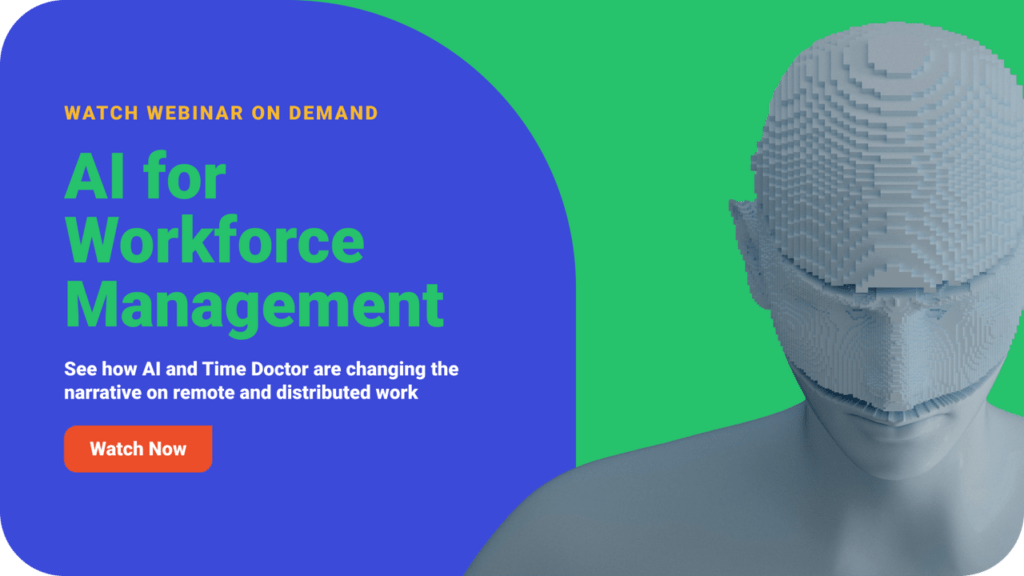The potential of AI has recently received a lot of attention in the field of workforce management. A new article or blog post on how AI is changing the way we work appears every day, making grand claims about increased productivity, accuracy, and a smarter workplace. But it can be challenging to distinguish fact from fantasy in the midst of all this excitement. So, what’s the real story behind AI in workforce management? How much of the hype is reflected in real-world applications?
In order to cut through the hype and get to the core of the matter, in this post we will examine AI for workforce management in further detail. We’ll look at how AI actually affects the workforce, the real advantages it offers managers and their teams, and how you can integrate AI into your workforce management plans. So, let’s dive in and uncover the reality behind the AI revolution in workforce management!
Table of Contents
- Understanding AI workforce management
- How AI helps in decision-making
- Efficiency and automation with AI
- Boosting employee engagement with AI
- Benefits of predictive analytics in workforce management
- Addressing concerns around AI in workforce management
- Choosing the right AI tool for workforce management
Understanding AI workforce management
So, what exactly is AI for workforce management? It’s using artificial intelligence technologies to help manage your workforce more effectively and efficiently. This includes tasks like scheduling, payroll, and even employee engagement, and it involves using AI tools that can analyze data, predict trends, and even automate certain tasks. To put it simply, it’s like having a super-smart assistant that can take care of workforce management’s tedious tasks, giving you more time to concentrate on the human side of things.
AI in workforce management isn’t some futuristic fantasy; it’s already here and changing the way we work. By automating regular operations like scheduling and payroll, managers may free up time to concentrate on more crucial issues like employee engagement and development.
AI for workforce management is about using technology to make wiser and more informed decisions, instead of simply automating activities. Managers may better understand their workforce by using AI technologies to evaluate data and patterns. This will enable them to make more educated decisions about scheduling, staffing, and other issues. Additionally, managers can be more proactive in their approach, planning, and foresight by being able to anticipate future trends.

How AI helps in decision-making
Sometimes, it seems like a never-ending juggling act trying to manage a workforce. You must make calendars, allocate projects, and monitor performance while also keeping an eye on your team’s long-term requirements. It’s a lot to handle, and let’s face it, even the best of us could use a little help.
Enter AI for workforce management. It’s like having a trustworthy friend who will always have your back. AI handles the specifics so you can concentrate on the big picture. How is this accomplished? Let’s check.
1. Making sense of the data
AI is like a master detective in data analysis. It sifts through mountains of data to spot trends and patterns that might take humans days or weeks to uncover. Whether identifying the peak times for employee productivity or flagging potential issues with workflow, AI gives you the insights you need to make informed decisions.
2. Forecasting made easy
AI is a bit of a fortune teller, too. It uses predictive analytics to give you a heads-up on future workforce needs. Whether planning for the next big project or anticipating seasonal fluctuations, AI helps you stay one step ahead.
3. Custom solutions for every employee
AI isn’t just a one-size-fits-all approach. It understands that every employee is unique and deserves a tailored approach. AI helps you make decisions that consider individual preferences, skills, and availability. It’s like having a personalized playbook for every member of your team.
4. Avoiding decision fatigue
Let’s be honest, constantly making decisions can be exhausting. With AI handling routine tasks, you can avoid decision fatigue and stay sharp for the important calls that require your unique human touch.
AI isn’t about replacing you as a manager. It’s about giving you the knowledge and resources you need to choose the best course of action for your team. You can be the dependable, responsible, and practical leader your team needs with AI.
Efficiency and automation with AI
Maintaining an accurate record of everyone’s schedules, tasks, and performance indicators may easily turn into a full-time job when managing a team. You need tools that will help you manage everything while not adding to your already excessive to-do list. That’s where AI comes into play.
Workforce management tools powered by AI act as a trusted assistant by automating and streamlining many of the repetitive chores that are part of the job. Let’s discuss some of the ways artificial intelligence can simplify your life:
1. Automated scheduling
Gone are the days of manually creating and adjusting employee schedules. AI tools can generate optimized schedules based on employee availability, preferences, and business needs. This saves you time and ensures fair and balanced schedules that keep your team happy.
2. Time tracking
AI can help automate the time tracking process, ensuring accurate records and reducing the risk of human error. With AI monitoring work hours, you can focus on more important tasks while keeping an eye on productivity.
3. Attendance management
Dealing with attendance issues, like tardiness or absenteeism, can be a hassle. AI tools for workforce management can automatically track attendance, send reminders, and even flag patterns that may need addressing. That way, you’re always in the loop without having to micromanage.
4. Task allocation
Assigning tasks to the right people can be a juggling act. AI tools can help by analyzing employee skills, availability, and workload, and then automatically allocating tasks based on these factors. This ensures a more efficient distribution of work and helps prevent burnout.
5. Performance monitoring
Keeping track of everyone’s performance can be time-consuming. AI systems can automatically gather and analyze performance data, providing you with insightful reports and highlighting areas that may need attention.
6. Adapting to changes
AI tools are handy and can adapt quickly to changes in the workforce, like new hires or unexpected absences. They can adjust schedules and task allocations on the fly, saving you time and ensuring continuity.
The bottom line is that AI workforce management tools are about efficiency and automation. They take care of the little things so you can concentrate on the greater picture—leading your team, forming connections, and reaching goals.

Boosting employee engagement with AI
Let’s talk about something every manager knows is essential but can be tricky to nail down – employee engagement. We all want a team that’s enthusiastic, committed, and invested in their work. But how do you foster that kind of engagement, especially when juggling many other responsibilities?
Enter AI workforce management tools. These tools can help boost employee engagement in ways you might not have considered before. Here’s the scoop on how AI can help you create a more engaged and motivated team:
1. Personalized schedules
We all have our own rhythms and preferences. AI can help create schedules tailored to employee preferences, such as preferred work hours or days off. This shows employees that their needs are valued and contributes to a better work-life balance.
2. Skill matching
AI tools can analyze employee skills and experience, ensuring they’re assigned tasks that match their strengths. This leads to increased job satisfaction and gives employees the opportunity to shine and show off their expertise.
3. Feedback and recognition
AI can help track employee performance and achievements, making it easier to provide timely feedback and recognition. Recognizing your team’s hard work boosts morale and shows that you appreciate their contributions
4. Career development
AI can identify skill gaps or areas where employees might benefit from additional training. By supporting their professional growth and development, you show employees that you’re invested in their long-term success.
5. Communication and collaboration
AI tools can facilitate communication and collaboration within your team by streamlining communication channels, suggesting collaboration opportunities, and helping employees stay connected, even when working remotely.
6. Employee surveys
AI can help design and analyze employee surveys, giving you insights into their needs, concerns, and suggestions. By listening to their feedback and taking action, you show employees that their opinions matter and that you’re committed to creating a positive work environment.
By leveraging AI in your workforce management, you show your team that you value and support them. It’s a win-win situation – more engaged employees lead to a more successful business.
Benefits of predictive analytics in workforce management
Let’s get into something that sounds fancy but is super practical – predictive analytics. In simple terms, it’s like having a crystal ball that helps you foresee workforce trends and make smarter decisions. Sounds pretty cool, right? Let’s talk how predictive analytics can give you an edge in workforce management:
1. Anticipating staffing needs
Predictive analytics can help you identify patterns in demand, allowing you to anticipate busy periods and staff up accordingly. No more last-minute scrambles to find extra help – you’ll be prepared and ready to handle the rush.
2. Reducing turnover
By analyzing employee data, predictive analytics can help you identify factors that may lead to turnover, such as workload, job satisfaction, or engagement levels. This way, you can address potential issues before they escalate, retaining valuable team members.
3. Optimizing scheduling
With predictive analytics, you can create data-driven schedules that take into account factors like employee availability, business needs, and even weather patterns. The result? More balanced and efficient schedules keep everyone happy.
4. Identifying training opportunities
Predictive analytics can pinpoint areas where employees may benefit from additional training or development. Investing in your team’s growth boosts their job satisfaction and performance.
5. Improving customer experience
By anticipating staffing needs and ensuring your team is well-trained, predictive analytics helps you deliver a top-notch customer experience. Happy customers mean more business, so it’s a win-win!
Predictive analytics is a powerful tool that can help you stay ahead of the curve and make data-driven decisions. By leveraging this technology in your workforce management, you’ll be prepared for whatever comes your way and have a more engaged, productive team.
Addressing concerns around AI in workforce management
AI sounds amazing, right? But it can also be a little intimidating. You may have concerns or skepticism about using AI in workforce management, and that’s perfectly okay. Let’s take a moment to address some of the common concerns:
1. Will AI replace human jobs?
The short answer? No. AI is here to assist, not replace. It’s about streamlining processes and providing insights to make your job easier. Think of it as a trusty sidekick that helps you handle the basic stuff so you can focus on the bigger picture.
2. Is AI too complex to use?
Let’s put this myth to bed. AI for workforce management tools are designed to be user-friendly and intuitive. You don’t need to be a tech wizard to reap the benefits. Plus, plenty of resources and support are available to help you get started.
3. Can I trust AI with sensitive data?
We get it, trusting AI with your workforce data is a big deal. But rest assured, most AI tools prioritize data security and have robust measures to protect your information. Just be sure to choose a reputable provider and follow best practices for data protection.
4. Will AI affect employee morale?
Worrying about how your team will react to AI tools is natural. The key is communication. Let your team know that AI is here to support them, not monitor or replace them. You can create a positive and supportive environment by involving them in the process and highlighting the benefits.
5. Is AI worth the investment?
Although implementing AI in workforce management can be expensive, the results are long-lasting. You may save time, cut costs, and increase productivity by automating processes, streamlining scheduling, and enhancing employee engagement.
AI can be a valuable tool in achieving ways to improve your team’s experience and make your job easier. Concerns are okay, but don’t let them hold you back from exploring its benefits to workforce management.
Choosing the right AI tool for workforce management
So, you’re ready to try out AI for workforce management. But how do you choose the right tool? It’s like finding the perfect pair of shoes – you want something that fits your needs, feels comfortable, and doesn’t break the bank. Don’t worry; we’ve got you covered. Here are some tips to help you find the perfect AI tool for your workforce management:
- Identify your needs: First things first, make a list of your workforce management needs. Do you need help with scheduling, time tracking, or performance monitoring? Knowing your specific needs will help you choose a tool that meets your requirements.
- Check for user-friendliness: We are all aware that time is money, so you don’t want to waste it trying to understand a complicated system. To get started quickly, look for a program with a clear user interface and simple features.
- Consider integration capabilities: You probably have other software tools you’re using, like payroll or HR systems. Choose an AI tool that can easily integrate with your existing systems, so you can have all your information in one place.
- Test customer support: You know what they say – you never truly know a company until you need their customer support. Make sure your chosen AI tool has a responsive and helpful support team. That way, if you have any issues, you know you’re in good hands.
- Evaluate security features: Your workforce data is valuable, and you want to protect it. Check out the AI tool’s security features and make sure they meet your standards. You can also read reviews or ask for recommendations from others in your industry.
- Budget considerations: Let’s be real, budget matters. Compare the costs of different AI tools and make sure they align with your budget. Don’t forget to factor in additional costs, like training or integration fees.
- Take it for a test drive: Most AI tools for workforce management offer free trials or demos. Use this opportunity to test the tool and see if it meets your needs. It’s like trying on those shoes before buying – you want to ensure they’re a good fit.
With these tips in mind, you’ll be well on your way to finding the perfect AI tool for workforce management for your team.
Conclusion
The world of AI for workforce management may seem like something out of a sci-fi movie, but it’s here, and it’s changing the game. From optimizing schedules and automating tasks to boosting employee engagement and providing valuable insights, AI tools are helping managers like you take workforce management to the next level.
Being skeptical or slightly intimidated is okay – that’s just part of embracing something new. But trust us, the benefits are real and worth exploring. AI can be a valuable ally in achieving that goal. So take that leap, try an AI tool that suits your needs, and watch your workforce management grow.

Andy is a technology & marketing leader who has delivered award-winning and world-first experiences.


